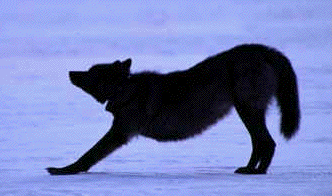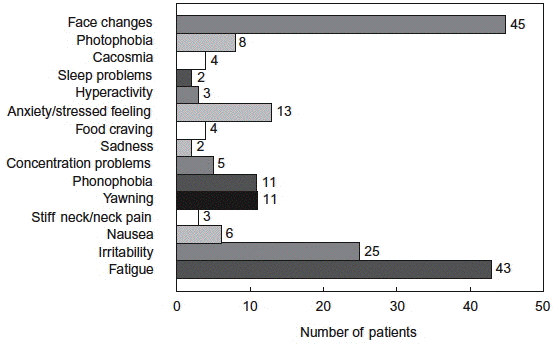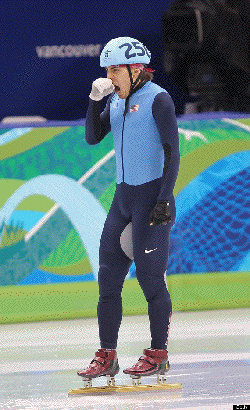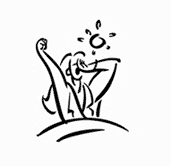
samedi 1 mai 2010 la lettre d'information du site baillement.com N°89 Si vous ne voyez pas les images, cliquez ici pour lire cette lettre dans votre navigateur. If you cannot see pictures below, to view the email in your web browser click here baillement.com est libre d'accès, base documentaire pour comprendre, chercher, travailler
-
Le bâillement chez le chien, - Canis lupus familiaris:
- Approches ethologique,
- pharmacologique et clinique
- Nathalie Tomczyk
- Nathalie Tomczyk a soutenu sa thèse de doctorat vétérinaire le 3 décembre 2009 à l'Ecole Nationale Vétérinaire d'Alfort.
- "...seeing a dog and horse and man yawn, makes me feel how much all animals are built on one structure" Charles Darwin 1838, Notebook
- Dogs catch human yawns
- Joly-Mascheroni RM, Senju A, Sheperd AJ
- Biology letters
- Animal Behaviour
- 2008;4(5):446-448
- School of psychology, Birkbeck, London
- Adapting to the human world:
- Dogs' responsiveness to our social cues
- Reid PJ.
- Behavioural Processes
- 2008;80(3)325-333.
- Comprehension of human pointing gestures in young human-reared wolves (Canis lupus) and dogs (Canis familiaris)
- Virányi Z, Gácsi M, Kubinyi E, et al.
- Anim Cogn
- 2008;11(3):373-387
- Human-like social skills in dogs?
- Hare B, Tomasello M.
- Trends Cogn Sci
- 2005;9(9):439-444
- The domestication of social cognition in dogs
- Hare B, Brown M, Williamson C, et al.
- Science
- 2002;298(5598):1634-1636
-
Yawning in dogs, Canis lupus familiaris - An ethological, pharmacological and clinical approach
- The study of yawning by dogs has not been well developped for the last past decades. The causality of this behavior common to allmost all the vertebrate species and its finality remains still mysterious.
- An experimental ethological approach lead N. Tomczyk to describe and analyze yawning in dog and to define the contexts of its apparition, and notably the postural context and the relation between transitions of activity levels.
- A clinical approach tented to highlight an eventual relation between clinical sate and the yawning frequency.
- Then pharmacological experimental study has permitted to highlight the neurophysiological bases of yawning in dog, and notably the link between dopaminergic pathways, which are in common with those of vomiting.
- Some reasons for dog yawning Gail T. Fisher

- Le bâillement chez le chien, Canis lupus familiaris
- Une approche éthologique, pharmacologique et clinique
- L'éthologie décrit des
bâillements et des pandiculations chez plusieurs
vertébrés: félidés,
canidés, singes,
hippopotames,
autruches, poules
etc. Les données publiées concernant le
Chien sont encore fragmentaires. Le bâillement du
Chien est-il similaire à celui des autres
vertébrés ? Apparaît-il dans des
conditions particulières qui lui sont propres ?
Quelle signification lui donner lorsqu'il apparaît
lors d'interactions avec l'humain ? Le
bâillement du Chien a-t-il une valeur
sémiologique en médecine
vétérinaire ? Cette thèse
essaie de répondre à toutes ces questions.
Une étude de pharmacologie expérimentale complémentaire a permis d'illustrer les bases neurophysiologiques du bâillement chez le chien, et notamment de mettre en lumière le lien entre les voies dopaminergiques qui lui sont communes avec celles du vomissement.
- Teaching Dogs to Yawn, Sneeze, and Implications for Preparedness Theory and Observational Learning
- JR. Perkins
- Coping with fear and stress: licking and yawning
- SR. Lindsay
- Handbook of Applied Dog Behavior and Training 2000
- Behavioural, saliva cortisol and heart rate responses to different types of stimuli in dogs
- Bonne Beerda, Matthijs B. H. Schilder, Jan A. R. A. M. van Hooff, Hans W. de Vries and Jan A. Mol
- Applied Animal Behaviour Science 1998;58(3-4):365-381.
- Puppy behaviours when left home alone: a pilot study
- Diane Frank, Michela Minero, Simona Cannas, Clara Palestrini
- Applied Animal Behaviour Science 2007;104(1-2):61-70.
- Evaluation of the effects of a socialization program in a prison on behavior and pituitary&endash;adrenal hormone levels of shelter dogs
- Michael B. Hennessy, Angela Morris and Fran Linden
- Applied Animal Behaviour Science 2006;99(1-2):157-171
-
The first complete and authoritative book on yawning - The Mystery of Yawning in Physiology and Disease
- Olivier Walusinski Editor
- We are proud to announce the availability of our book and I would especially like to thank all my coauthors for their valuable work, which is essential to the success of this book.
- Contents
- Preface: Bogousslavsky, J.
- Foreword: Walusinski, O.
- Historical Perspectives: Walusinski, O.
- Popular Knowledge and Beliefs: Walusinski, O.
- Yawning throughout Life: Giganti, F.; Salzarulo, P.
- Fetal Yawning: Walusinski, O.
- Sleep, Sleepiness and Yawning: Giganti, F.; Zilli, I.; Aboudan, S.; Salzarulo, P.
- Interplay between Yawning and Vigilance: A Review of the Experimental Evidence: Guggisberg, A.G.; Matthis, J.; Hess, C.W.
- The Hidden Sexuality of the Yawn and Future of Chasmology: Seuntjens, W.
- Non-Human Primates: A Comparative Developmental Perspective on Yawning: Anderson, J.R.
- Punishment-Induced Fear Modifies the Daily Course of Yawning in Rats: Moyaho, A.; Valencia, J.
- A Thermoregulatory Behavior: Gallup, A.C. Neuropharmacology of Yawning: Collins, G.T.; Eguibar, J.R.
- Yawn, Yawn, Yawn, Yawn;Yawn, Yawn, Yawn! The Social, Evolutionary and Neuroscientific Facets of Contagious Yawning: Platek, S.M.
- Developmental and Comparative Perspectives of Contagious Yawning: Senju, A.
- Methodological Problems in the Study of Contagious Yawning: Campbell, M.W.; de Waal, F.B.M.
- Exploring Yawning with Neuroimaging: Nahab, F.B.
- Associated Movements in Hemiplegic Limbs during Yawning: Meenakshisundaram, R.; Thirumalaikolundusubramanian, P.; Walusinski, O.; Muthusundari, A.; Sweni, S.
- Associated Diseases: Walusinski, O.
- Frontiers of Neurology and Neurosciences, Vol. 28
- Series Editor: Bogousslavsky, J. (Montreux)
- ISSN 1660-4431 / e-ISSN 1662-2804
-
- L'agence Reuters a diffusé le 28 avril 2010 une dépêche consacrée au bâillement à l'occasion de la prochaine conférence en juin à Paris. Cette dépêche a été reprise par de très nombreux média de par le monde et traduite en espagnol (by Vicky Buffery).
-
The prevalence of premonitory symptoms in paediatric migraine - a questionnaire study in 103 children and adolescents
- Cuvellier J-C, Mars A, Vallée L.
- Cephalalgia
- 2009;29:1197-1201
-
Migraine and yawning - Migraine affects 4-10% of school-aged children. It is characterized by periodic, paroxysmal episodes of headache accompanied by nausea, vomiting, abdominal pain and intense desire to sleep.
- Migraine is characterized by a great variability of phenotypical expressions and it has long been recognized that migraine headaches are frequently associated with a constellation of other non-headache symptoms.
- The characterization of premonitory symptoms has been poorly studied in children and adolescents. It is the aim of this article. The authors recognize premonitory yawns by 11 % of the children.

- Migraine et bâillements
- La migraine affecte entre 4 et 10% des enfants d'âge scolaire. La migraine est caractérisée par des épisodes itératifs paroxystiques de mal de tête, accompagnés de nausées, vomissements, douleurs abdominales et envies de dormir.
- Les expressions phénoménologieques des crises sont très variables d'un enfant à l'autre, voir d'une crise à l'autre chez le même enfant. Il y a longtemps que l'on sait qu'une vaste constellation de troubles sont fréquemment associés à la migraine mais aussi lors de maux de tête non-migraineux.
- Le signes prémonitoires des crises ont été très peu étudiés de façon rigoureuse chez l'enfant. C'est l'objet de ce travail qui retrouve, chez 11% des enfants, des bâillements prémonitoires.
-
La civilité puérile - Didier Erasme
- 1469-1536
- De la décence et de l'indécence du maintien
- traduction, édition et introduction par Franz Bierlaire
- S'il arrive d'éternuer en présence de quelqu'un, il est honnête de se détourner un peu ; quand l'accès est passé, il faut faire le signe de la croix, puis soulever son chapeau pour rendre leur politesse aux personnes qui ont salué ou qui ont dû le faire (car le bâillement, comme l'éternument, rend quelquefois l'ouïe moins fine), et s'excuser ou remercier. C'est chose religieuse de saluer celui qui éternue, et s'il y a là des gens plus âgés qui saluent quelque personne de mérite, homme ou femme, un enfant doit se découvrir. Il n'appartient qu'aux sots d'étemuer bruyamment et de recommencer à plaisir, pour faire parade de leur vigueur. Réprimer un accès naturel est le fait de ces niais qui font passer la politesse avant la santé.
- Si le bâillement te prend et que tu ne puisses ni te détourner ni te retirer, couvre-toi la bouche de ton mouchoir ou avec la paume de la main, puis fais le signe de la croix.
- Croyances et bâillements
- In Europe
- Around 590 AD, during the times of Pope Gregory the Great, a bubonic plague epidemic raged through Europe, decimating the population and inspiring numerous superstitions: "Yawning was fatal then, and the habit of signing the cross in front of the mouth originated during the times of the plague. (...) There was a plague they called inguinal, because a bubo appeared in the groins, causing men to die suddenly in the streets, in their houses, at play, during a meal. Their souls left their bodies when they sneezed or yawned. This is why we said 'God bless you' to those who sneezed. Those who yawned made the sign of the cross over their mouths". Even the sceptical Michel de Montaigne conced that he made the sign of the cross before his mouth while yawning, given evidence for the education's power. In Austria, in the case of a yawning baby who was not able to perform the sign of the cross, an older person would perform this gesture in front of the infant's mouth in order to prevent illness ans bad luck (Le Camus,1769).
-
Why does Apolo Anton Ohno yawn before his races? -

-
Apolo Ohno Yawning: "Yawns Provide Strategic Advantage" - Apolo Ohno yawning may have been a strange sight to viewers of the Vancouver Olympics. Even as he became the most decorated U.S. Winter Olympian of all time, Ohno's pre-race yawn appeared out of place.
- Yet according to Fourth Place Medal, Ohno's yawning is all about strategy. "The yawning lets extra oxygen into his lungs in the seconds before bursting across the ice," writes Martin Rogers. And indeed, as Ohno's rigorous training methods show, he seeks every advantage possible. Is this comment correct ?
- Why Does Apolo Ohno Keep Yawning?
- The announcer commented that a flood of e-mails have been pouring in with that one question: Why does Apolo Ohno yawn so much? Well, Ohno was asked this question in an interview and he answered that he yawns due to a psychological thing; the yawning was more reflective of his style, and had nothing to do with fatigue.
- Apolo Ohno assured the interviewer that he gets plenty of sleep and that he's well-rested, but that the yawning is akin to the yawning that lions in the wild do. "I want to be a lion," Apolo said with a big smile.
- "I wondered about Ohno's yawning myself; I noticed that other athletes weren't doing this. Yawning doesn't always indicate fatigue or lack of sleep. It may very well be a habit in many people. It is said that a person will yawn simply as a result of seeing someone else do it."
- The 500 meter short track race is not Apolo's strongest event, but on Wednesday night, Feb. 24, he barely crossed the finish line in first place.
- Contrary to the comments of the journalist, it got him no additional oxygenation. But as number the other sportsmen (parachutists for example) or artists before their show, these yawns trigger a looseness simultaneously a better cognitive concentration on the purpose to achieve.

- Les bâillements d'un coureur de patinage de vitesse américain à Vancouver
- Apolo Ohno a intrigué spectateurs et commentateurs lors des épreuves de patinage de vitesse. Avant chaque course, Apolo Ohno bâillait de façon répétée. Contrairement aux alégations du commantateur, cela ne lui procurait aucune oxygénation supplémentaire. Mais comme nombre d'autres sportifs (parachutistes par exemple) ou artistes avant leur spectacle, ces bâillements assurent une décontraction simultanément à une meilleure concentration cognitive sur le but à atteindre.
-
My Dear, - It is our great pleasure to announce the "First International Conference on Yawning" to be held in Paris, France, Juni 24-25, 2010.
- The FICY 2010 will provide a forum for in-depth assessment of the challenges involved in the dynamic and fast moving field of research and conjectures on this intriguing behavior : yawning. Over 20 leading experts from 8 countries around the world have already confirmed they will be participating. FICY will bring together clinicians, researchers, ethologists, pharmacologists and other allied professionals to discuss and present the latest important developments in the field.
- To view the defintive timetable
- This day, no sponsor agree to support the organization of FICY. Thus, we need that all interested participants register for these two days meeting. We need that you invite your colleagues and promote this conference around, especially by way of knowledge societies'letters, if you can.
- We look forward to your participation in this outstanding conference !
- REGISTER
OPEN
Chère amie, cher ami, - Nous avons le grand plaisir de vous annoncer que la "Première Conférence Internationale sur le Bâillement" aura lieu à Paris les 24 & 25 juin 2010.
- Cette conférence sera l'occasion d'une présentation des derniers développements de la recherche et des hypothèses ou théories concernant ce comportement mystérieux qu'est le bâillement. Des experts, une vingtaine, provenant de 8 pays différents des 5 continents, ont d'ores et déjà acceptés d'animer ces deux journées. Seront réunis des cliniciens de toutes disciplines, des chercheurs, des éthologues, des pharmacologues et d'autres professionnels de disciplines satellites qui discuteront et présenteront leurs travaux personnels les plus récents.
- Voir le programme définitif
- A ce jour, l'organisation de cette conférence ne bénéfice d'aucun sponsor. Ce sont donc les droits d'inscription de chacun qui permettront de couvrir les frais. Votre inscription sera donc indispensable. Mais nous avons aussi besoin que vous assuriez la promotion de cette conférence autour de vous, que vous en informiez vos collègues et amis, et, si vous en avez la possibilité, d'user du canal des sociétés savantes auxquelles vous appartenez pour diffuser la tenue de cette réunion originale et inédite.
- Nous comptons sur votre participation et votre aide !
- Les inscriptions sont ouvertes
-
Macaca radiata
-
Autres documents mis en ligne ce mois-ci :
- Pandiculari De verborum significatione Sextus Pompeius Festus A Dacier 1681
- Tractatus physico-medicus in homine. Craanen Th 1722
- Stretching and Yawning, Washington, D.C. Johnson FB 1899
- Bâilleur de fond. E Launet. Libération du 31 mars 2010
- How God changes your brain: yawn Newberg A, Waldman MR
- L'éveil et le Lavabo P. Collin
- Yawning and the reticular formation Askenasy J, Askenasy E
- Coliques du cheval. Equine colic
- Dihydrotestosterone Propionate Effects on Dominance and Sexual Behaviors in Gonadectomized Male and Female Rhesus Monkeys Cochran CA, Perachio AA
- Testosterone Propionate Treatment of an XY Gonadal Dysgenetic Chacma Baboon.Bielert C
Résultats du sondageau 1 mai 2010 Recherche par mot du site
-
Nombre de questionnaires remplis : 4456 - Combien de fois bâillez-vous par jour ? <5 = 23,5%.. 5-10 = 24,1%.. 10-15 = 15,3%.. 15-20 = 10,3%.. >20 = 26,8%
- Ressentez-vous des baillements excessifs ?
- 56,9% = non, tant mieux
- 33,8% = oui et je ne sais pas pouquoi
- 8,6% = oui et je prends des antidépresseurs
- 1,0% = oui et je prends des anti-épileptiques
- 5,8% = oui et je prends d'autres médicaments
- 2,4% = oui et j 'ai des troubles neurologiques
- 2,3% = oui et j 'ai des troubles hormonaux
- 1,5% = oui et j 'ai des tics moteurs
- 1,6% = oui et j 'ai des tocs
- déclenchez-vous facilement le bâillement d'autrui ? 74,4%
- êtes-vous sensible au bâillement d'autrui ? 70,4%
- As a wag once said, a yawn is like economics, everyone has his pet theory and explanation for it.
- Comme un plaisantin a dit, un bâillement ressemble à l'économie, chacun a sa théorie favorite et son explication.
baillement.com baillement.info yawning.info écrits et réalisés par le Dr Walusinski
lire les lettres précédentes d'information du site tapez votre email - give your email pour ne plus recevoir cette lettre - to unsubscribe to the website's letter:




